What Is APS Protection?
APS is a linear protection mechanism. It can be used to protect tunnels (such as those created using MPLS, Ethernet, SR-TP, FlexE, and FlexE FG) and PWs.
What Is APS Protection?
APS is a linear protection mechanism. With APS configured, a protection link is reserved for a working link. If a signal failure or degrade occurs on a working link, its traffic is switched to the protection link.
In the case of bidirectional protection switching, APS coordinates the actions of both the source and sink ends, enabling them to perform traffic switchovers simultaneously, negotiate the switchover delay, and perform traffic switchbacks after a specified wait to restore (WTR) time elapses. APS protocol packets are always transmitted along the backup channel. Both the transmit and receive ends know that they receive APS protocol packets through each other's backup channel. This implementation helps determine whether both ends are configured with the same primary and backup channels. APS can be used to protect tunnels (such as those created using MPLS, Ethernet, SR-TP, FlexE, and FlexE FG) and PWs. Currently, end-to-end 1+1 protection and 1:1 protection are widely used. APS supports unidirectional and bidirectional switching, allowing switching to be performed within 50 ms, with only a short period of packet loss triggered by the link failure.
APS Protection Types
During end-to-end Ethernet transmission, APS works on both the working and protection links. In normal cases, traffic is transmitted along the working link. If the working link fails, traffic is switched to the protection link. The source end of an APS link functions as a bridge and selects the link from which traffic is sent. The sink end functions as selector and selects the link from which traffic is received.
APS is classified as 1+1 APS or 1:N APS based on whether traffic is always transmitted on the protection link. 1:1 APS is a special case of 1:N APS, which means that one protection link protects N working links. In the 1+1 model, traffic is replicated on both the working and protection links and transmitted separately. In the 1:1 model, the protection link does not carry traffic when the working link is normal. Traffic is switched to the protection link only when the working link fails.
1+1 Protection
In 1+1 protection mode, as shown in the following figure, services are transmitted on both the working and protection links at the source end, and the sink end selectively receives services based on the link status and external commands. In other words, the source end dually transmits services, and the sink end selectively receives services.
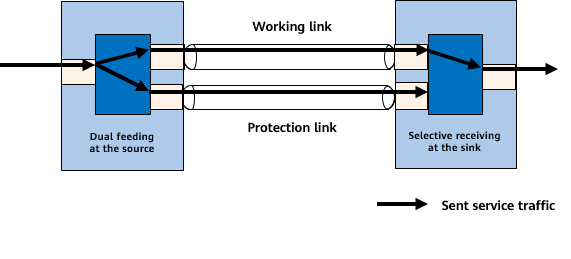
APS 1+1 protection
1:1 Protection
In 1:1 protection mode, as shown in the following figure, services are transmitted on only the working link at the source end, and the protection link remains in the idle state. Both the source and sink ends selectively transmit services according to the link status and external commands. That is, the source end selectively transmits services and the sink end selectively receives services.
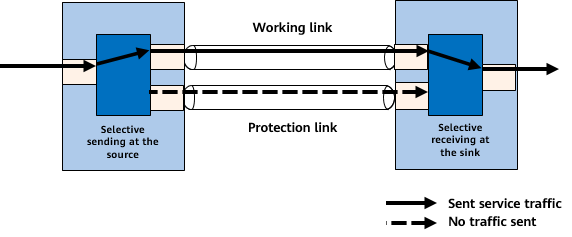
APS 1:1 protection
In 1+1 protection mode, switching is simple and fast because it is performed only at the sink end. However, the source end occupies two links for transmission, resulting in low resource utilization. In contrast, 1:1 protection occupies only the working link in normal cases, and the protection link is idle. While the working link works normally, additional services can be transmitted along the protection link. Therefore, the bandwidth utilization is high. However, switching needs to be performed at both ends, and the switching duration is relatively long.
APS Protection Switching Modes
Unidirectional Switching
In unidirectional switching mode, if the signal in one direction of the working link fails, switching is performed only in the affected direction. The signal in the other direction is not switched (as long as it does not fail), and services are still selectively received from the working link. In other words, switching at the source end and switching at the sink end do not affect each other.
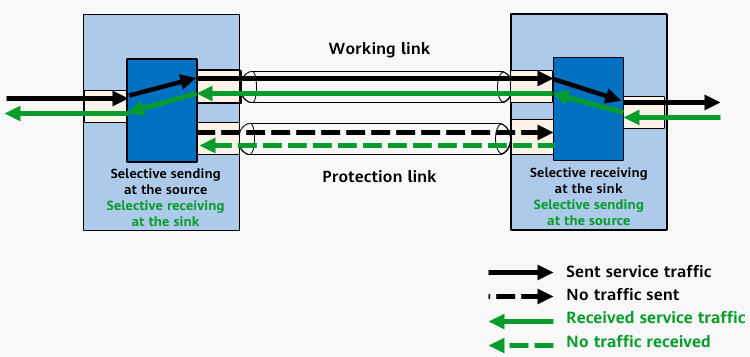
Unidirectional protection switching when the working link fails
Bidirectional Switching
In bidirectional switching mode, if the signal in one direction of the working link fails, switching is performed in both directions regardless of whether the signal in the other direction fails. That is, both the source and sink ends use either the working link or the protection link.
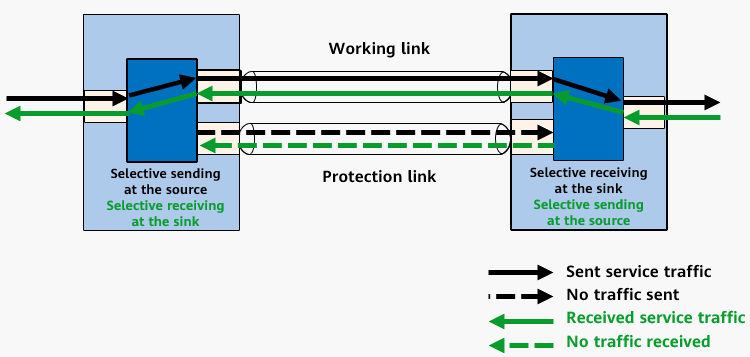
Bidirectional protection switching when a link fails
Unidirectional switching is not recommended because services are transmitted and received along different paths. In bidirectional switching mode, services are transmitted and received along the same path with similar delay, facilitating maintenance.
Principles of APS Protection Switching
1+1 Unidirectional Protection
In this model, the source end permanently replicates and transmits traffic on each of the working and protection links. The source end of a link periodically sends OAM CCMs, and the sink end performs detection. If the sink end does not receive CCMs within three consecutive periods (about 10 ms; each period is 3.3 ms), it considers that the link signal fails. In this case, the selector at the sink end uses the protection link to receive traffic. Because each direction is independent, the selector only needs to work based on local information and does not need to exchange APS packets to negotiate information between the two ends.
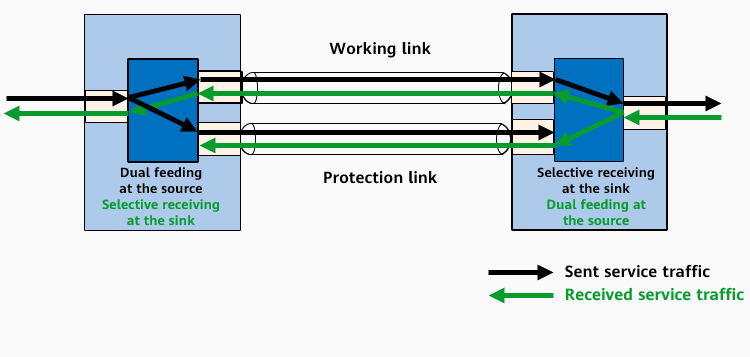
Unidirectional protection switching when a link fails
1+1 Bidirectional Protection
In this model, the source end permanently replicates traffic on each of the working and protection links. The source end of a link periodically sends OAM CCMs, and the sink end performs detection. If the sink end does not receive CCMs within three consecutive periods (about 10 ms; each period is 3.3 ms), it considers that the link signal fails. In this case, both the source and sink ends need to perform state switching. In other words, the bridges and selectors at both ends need to switch traffic to the protection link. As such, APS packets need to be exchanged for information negotiation.
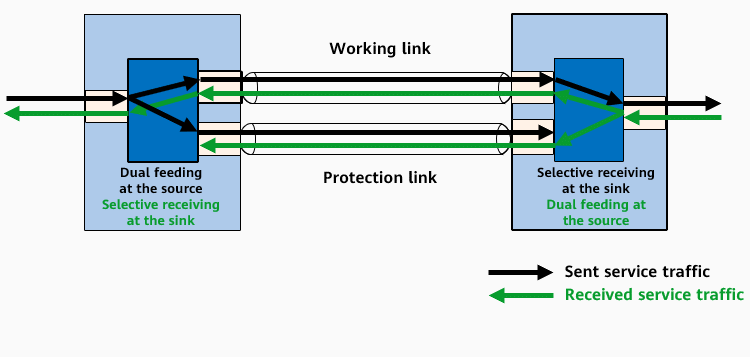
Bidirectional protection switching when a link fails
1:1 Unidirectional Protection
1:1 unidirectional switching requires the exchange of APS protocol packets. The source end of a link periodically sends CCMs, and the sink end performs detection. If the sink end does not receive CCMs within three consecutive periods (about 10 ms), it considers that the signal fails. In this case, the sink end immediately initiates switching and selectively receives services from the protection link. It also sends APS protocol packets to the peer end through the protection link, instructing the peer end to use the protection link to send packets. After receiving the APS protocol packets, the peer end immediately uses the protection link to send packets.
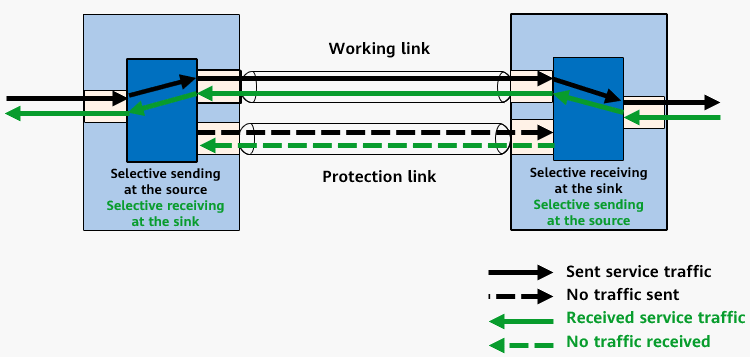
Unidirectional protection switching when the working link fails
1:1 Bidirectional Protection
1:1 bidirectional switching requires APS for interaction. The source end of a link periodically sends CCMs, and the sink end performs detection. If the sink end does not receive CCMs within three consecutive periods, it considers that the link signal fails. In this case, the sink end immediately initiates switching and uses the protection link to receive and send services. It also sends APS protocol packets to the peer end, instructing the peer end to use the protection link to send and receive packets. After receiving the APS protocol packets, the peer end immediately initiates switching.
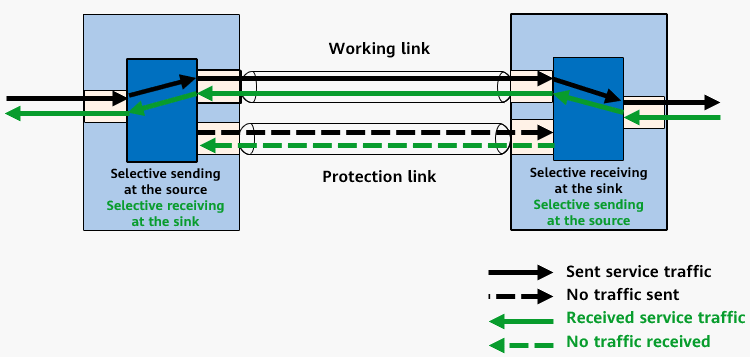
Bidirectional protection switching when a link fails
To sum up, the main difference between 1+1 protection and 1:1 protection lies in whether the protection link carries backup traffic when the working link is normal. In 1+1 bidirectional, 1:1 unidirectional, and 1:1 bidirectional protection modes, APS packets need to be transmitted between the source and sink ends for negotiation before switching can be initiated.
- Author: Xie Jiongye
- Updated on: 2022-12-08
- Views: 3674
- Average rating:






